American ash recreates the rich and emblematic elements of Polynesian culture at the Sofitel The Palm Dubai

Located on the iconic Palm Jumeirah, the hotel boasts 361 island chic inspired guest rooms and suites, as well as 182 fully serviced apartments, inspired in the Polynesian culture.
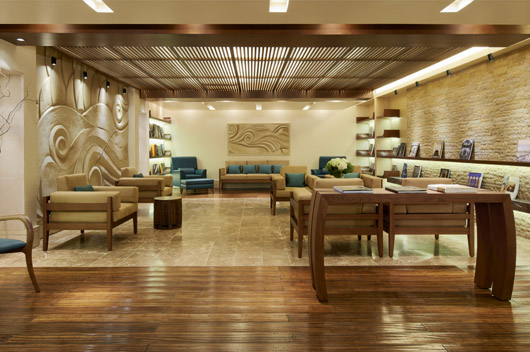 title="Más..." />
title="Más..." />
Sofitel Luxury Hotels celebrated the inauguration of Sofitel The Palm Dubai as its flagship Dubai property in a lavish opening ceremony in November 2013. More than 1,500 guests attended the exclusive soirée at the resort, which is located on the east crescent of the Palm Jumeirah. An array of local and international dignitaries and celebrities were in attendance along with Gregory Maliassas, Senior Vice President, Sofitel Middle East, Africa and Indian Ocean and world renowned French botanist, Patrick Blanc, the inspirational creator behind the unique vertical gardens featured throughout the property.
View of the resort from the sea
Nestled within the tranquil groves of the Palm Jumeirah, the resort is encapsulated by a private 500-meter stretch of pearlescent beach, enabling guests to indulge in breathtaking sea views overlooking the shores of the East Crescent. Totaling more than 100,000 square meters, Sofitel The Palm Dubai‘s distinct French luxury offering is embraced by rich and iconic elements of Polynesian culture and civilization. With an abundance of stunning organic architecture and lush vertical gardens, the resort reflects a timeless spirit and tropical allure.
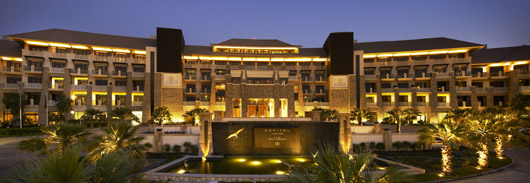
Main facade of the hotel at night
“Sofitel The Palm Dubai is well set to cater to the UAE's ever growing luxury leisure tourist market, as well as business travelers seeking refreshing locations beyond the mainstream downtown addresses,” said Gregory Maliassas, Senior Vice President, Sofitel Middle East, Africa and Indian Ocean. “The rare design elements conceptualized by Mirk Architecture and Patrick Blanc allow guests a total sense of escapism from the bustle of the city of Dubai.”

The Library
The hotel offers 361 guest rooms and suites, as well as 182 serviced residences, ideal for lengthier stays and boasts a multitude of food and beverage outlets, namely Studio du Chef, offering a modern take on traditional French cuisine; Porterhouse, the property's signature steak restaurant; Manava, the all-day dining restaurant; Hong Loong, offering authentic Chinese cuisine; Moana, where delectable seafood is prepared with fresh local ingredients, while Maui Beach Bar and Restaurant allows guests to relax while enjoying the aromas and treats from the BBQ.
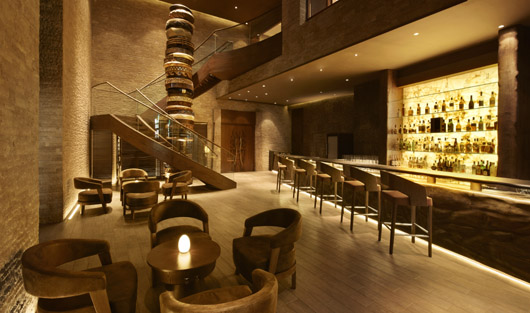
Porterhouse Bar
Spread over 3 levels, 2LIV Nightclub provides party goers unparalleled views of the Arabian Gulf and the ultimate in nighttime fun. Encompassing 2,500 square meters and 28 treatment rooms, So Spa offers guests the ultimate in relaxation and rejuvenation incorporating traditional Tahitian spa treatments. In addition, 1,500 square meters of meeting space including a ballroom and 4 conference rooms ensures that the hotel can cater for conferences, meetings, incentives, events and weddings, accommodating up to a maximum of 700 people.
“We wanted to create an alternative to the standard resort-like hotels in the city and by combining traditional Sofitel hospitality with the Polynesian theme, and from the feedback we have received thus far, we feel we have fulfilled this aim,” said Christophe Schnyder, General Manager, Sofitel The Palm Dubai. “The property's one-of-a-kind design transports guests on a sensory discovery, driven by the indoor green walls, the lush outdoor gardens and the 500 meter long private beach.”

Club Millesime

Ballroom - Cabaret
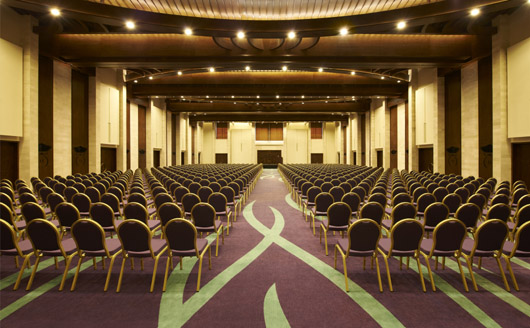
Ballroom - Theatre
Design Philosophy
In an attempt to take luxury back to basics, the Sofitel The Palm Dubai has been modeled on a Polynesian village, fresh with green foliage, cabana-style fittings, and flowing water features that greet guests as soon as they step inside. The lush, green, vibrant environment is the brainchild of Mahnaz Liaghat, CEO, Mahnaz International Design & Planning and formerly the Design Director of Mirk, who has paid particular attention to the island theme. The lobby itself is set below a traditional, natural wood cabana, complete with tranquil water elements that complement guest relaxation areas.
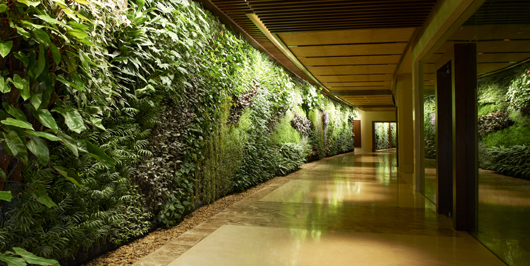
Green Wall
A special feature of the ground floor is a ‘living wall’ vertical garden planted by renowned botanist Patrick Blanc. The garden seemingly stretches for miles before the eyes as guests’ first venture into the hotel, and provides a wonderful ‘outdoors indoors’ experience. The Koru, a traditional fern symbolizing the embodiment of new life, accentuates the special vertical garden. Its spiraling tendrils add movement and life to the botanical feature. In addition, corridors and smaller spaces have been specially designed to evoke the fresh feeling of a green village, with plenty of American ash, bamboo, and earthy-toned surroundings. Taking a stroll through the hotel is in fact like walking through the woods, with dappled sunlight peeking through the treetops.

Main Lobby
According to Mahnaz, the client intended the resort to be a place of rediscovery and enchantment. As such, the design draws upon the style of the French Polynesian islands through a modern interpretation and translation of culture. Iconic symbols support the overarching design concept that gives the resort its unique and memorable identity. These symbols have been incorporated throughout the design to unify the feel and tone of the individual spaces. The positive message each carries with it reinforces the overall purpose of the resort itself.
“Our challenge was how to make a six story building feel like a Polynesian resort. More importantly, we wanted to showcase a new way of defining ‘luxury’ through the experience the resort provided. In keeping with the ‘less is more’ ethos, we have designed the resort incorporating natural (first-generation) materials such as stone, wood, water and nature, and combined this with subliminal design cues, in other words the fourth dimension, that influences our subconscious mind to make a space feel great and complete,” said Mahnaz.
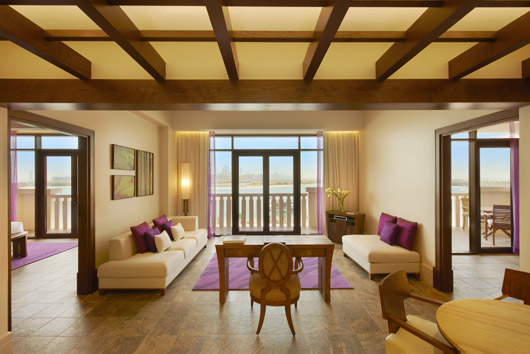
Opera Suite
Polynesian themes
Wherever guests wander, they are accompanied by traditional Polynesian motifs. Intricate details of the Koru, Gecko, Tiki, Turtle, Butterfly, and Tiare flower can be spotted on doors, walls, and floors; all of which symbolize peace, freedom, energy, connection, life, and new beginnings. A tiki comes in many forms, offering protection from evil spirits and its traits can take the form of what one wants the tiki to express. It is thus only fitting that the main entrance to the hotel features the tiki symbol on the massive wooden doors. According to Mahnaz, the wooden ceiling of the entranceway is similar to what is found inside the lobby, offering guests an invitation to explore.

Palm Suite - Dinning room
A space can be a simple transition, a passage to a paradise just beyond. As such, the lobby of the Sofitel The Palm Dubai carries the guest through to the resort outside, where personal rediscovery awaits. The ceiling is designed as a cabana and features the extensive use of American ash to reinforce the experience. In addition, simple and pure water features and vertical walls of floral plants surround the two sides of the lobby, immersing one in a lush green and vibrant environment found in traditional Polynesian villages. To emphasize the experience, lights bounce off the dynamic wood on the ceiling and combine with the green wall to give a truly spiritual meaning to this memorable space. Further, natural materials like water, stone, and wood, and the contrast of captured dark and light shadows and shades symbolize a journey through villages and passages to new experiences.
Mahnaz adds: “The reed ceiling and a path draw you towards a ‘Wall of History’ that has been designed to recall aspects of a traditional Polynesian village and their infusion within a modern setting. The wall visually explains the meaning behind the symbols used within the design, and as you walk through the rest of the resort, you begin to feel the connection to the tradition and culture. In addition, vertical plantings and the sharp contrast of light and dark escaping from the edges through the retail corridor create a soft and pleasant connection. The awning-like ceiling is designed to resemble a walk through alleys between villages.”
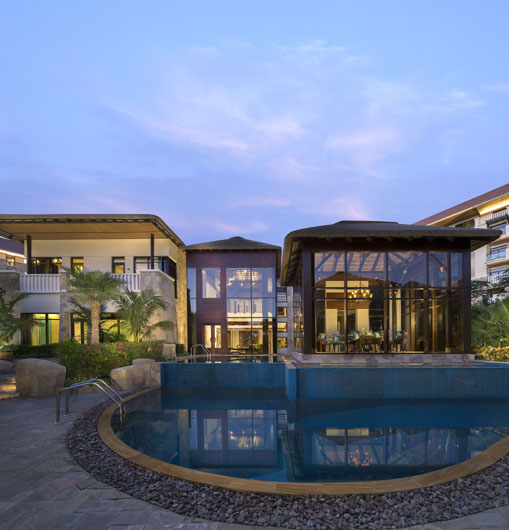
Lodge Villa 3 - exterior
Other noteworthy elements in the hotel include the checkout counter with its sculpted American ash wood trunks - a departure ticket to remember, according to Mahnaz. The lift lobby, which acts as a transition between the different Polynesian islands, combines wood and reeds and indirect light to bring memories back as if one were walking through nature. Throughout the corridors, the subtle mixture of light and shadows and shades bouncing off wood and stone symbolizes the journey through villages and passages to new experiences. In addition, the impressive ballroom celebrates life and its richness through the use of American ash in its ceiling, which has been designed to represent the bottom of a canoe. The canoe, which is integral to Polynesian culture, represents the progress along life's journey and is a symbol of changing life, travel, and adventure.
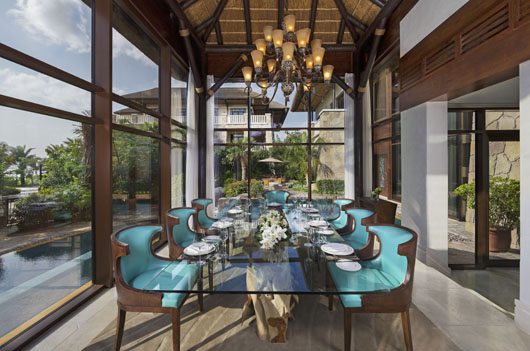
Lodge Villa 3 - dining room
Natural Living
Subtle design, natural raw materials and attention to detail combine perfectly in each room and residence at the Sofitel The Palm Dubai. Its 361 unique rooms and suites and 182 residences have been designed to provide a relaxed environment that focus on the beauty and simplicity of nature. For this reason, furniture and fixtures have been carved out of natural dark woods, predominantly stained American ash, raw stone and pale onyx. Indirect lighting in all living spaces evoke standing under trees in a forest, with the sunlight dappling through hundreds of leaves, making guests feel as though they’re really in a Polynesian village.

Luxury Room
Inside, exotic-looking stained American ash, vibrant, rich colors, and understated luxury features in every room. Each bathroom has been created with open-air in mind, with natural stone underfoot and rain-shower fittings overhead. Centralized stone baths overlook the airy living spaces while touches of blue and purple textiles complete the understated luxury allowing one to relax in a stone bath surrounded by onyx-adorned details overlooking the living space and balcony, or simply rest in the rooms inspired by nature. All in all, blooming colorful florals, the extensive use of ash and indirect light bouncing off stone and wood combine to create a peaceful and serene moment in every room.
Explaining the decision to use American ash, Mahnaz says: “Originally we specified reconstituted African walnut in an attempt to stay within the original budget. However, the client was keen on an exotic wood, which at the time did not match well with the design aesthetics of the project. As a result, we selected American walnut and created the initial mock up rooms. However, the quantity of walnut required for this project meant that it would have taken over five years to source. American ash, with its open grain finish and coarse uniform texture, was the next best alternative that was readily available, in line with the budget, and could satisfy the design requirements of the project. Looking at the resort today, I am proud that it stands as a unique product that is a testimony of the complete design.”
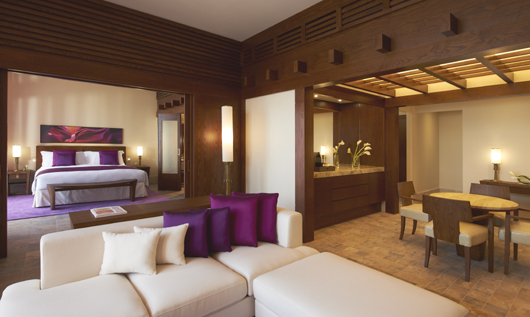
Prestige suite
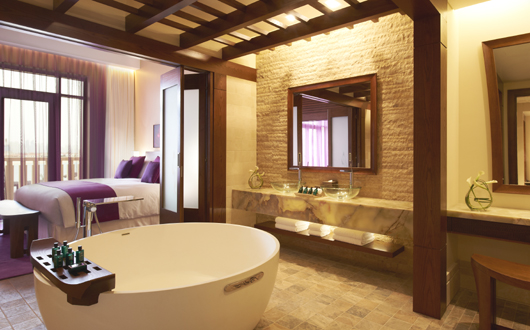
Prestige suite - bathroom
Embracing the Outdoors
The low-rise haven evokes elegance and serenity with its organic architecture: smooth lines, curves, and contours fall effortlessly on the eyes. Venturing out into the resort is like taking a stroll through a village, along brick pathways, meeting thatched-roof huts that gradually wind down to the unspoiled seafront. Lined with palm trees, the secluded stretch of beach affords magnificent views over the east crescent of Dubai's iconic Palm Island, and as far as the eyes can see out into the crystal blue waters of the Arabian Gulf.
“The new Sofitel The Palm Dubai epitomizes understated luxury combined with the utmost comfort. As our portfolio continues to grow across the world, we strive to meet the sophisticated needs of today's versatile travelers who expect and appreciate beauty, quality and excellence. I am confident that this spectacular resort will attract both global and regional discerning travelers and groups,” concludes Schnyder.

Cha House
Source: AHEC
Photography: Eric Cuvillier
Read more news related AHEC published at Infurma
For more information on American hardwood species and case studies, visit www.americanhardwood.org
News Infurma:
Online Magazine of the International Habitat Portal. Design, Contract, Interior Design, Furniture, Lighting and Decoration
